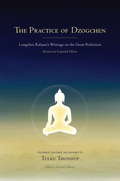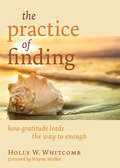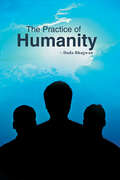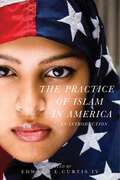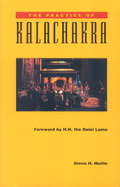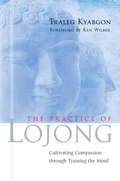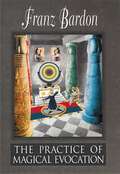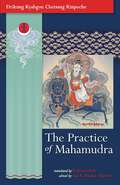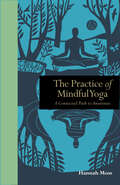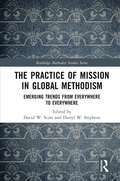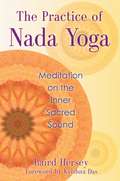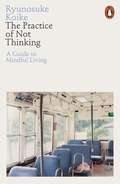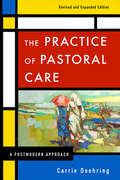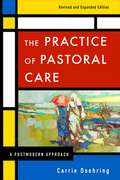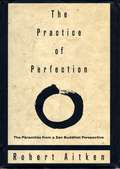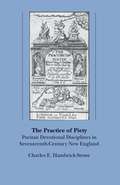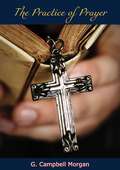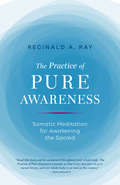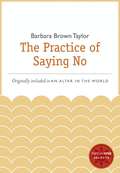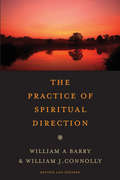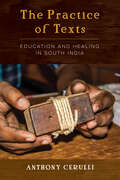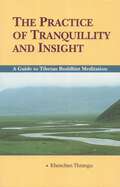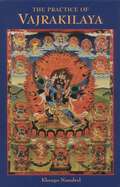- Table View
- List View
The Practice of Dzogchen: Longchen Rabjam's Writings on the Great Perfection
by Tulku Thondup Harold Talbott LongchenpaThis classic collection of texts on the meditation practice and theory of Dzogchen presents the Great Perfection through the writings of its supreme authority, the fourteenth-century Tibetan scholar and visionary Longchen Rabjam. The pinnacle of Vajrayana practice in the Nyingma tradition of Tibetan Buddhism, Dzogchen embodies a system of training that awakens the intrinsic nature of the mind to reveal its original essence, utterly perfect and free from all duality--buddha nature, or buddhahood itself.In The Practice of Dzogchen, Tulku Thondup translates essential passages from Longchen Rabjam's voluminous writings to illuminate and clarify this teaching. He also draws on the works of later masters of the tradition, placing Dzogchen in context both in relation to other schools of Buddhism and in relation to the nine-vehicle outline of the Buddhist path described in the Nyingma tradition. This expanded edition includes Counsel for Liberation, Longchenpa's poetic exhortation to readers to quickly enter the path of liberation, the first step toward the summit of Dzogchen practice.
The Practice of Finding: How Gratitude Leads the Way to Enough
by Wayne Muller Holly W. WhitcombSeeking is in vogue these days. Many of us are continually, even obsessively striving and seeking—for something or other. But are we ever satisfied? What is enough? Holly Whitcomb presents the spiritual practice of finding as the antidote to chronic seeking and as the doorway to a grateful awareness of having received enough. She reflects on wisdom distilled by the “finders”—poets, playwrights, psychologists, and theologians—and derived from her own experience. When we engage in finding, we recognize with humility and wonder that the universe contains possibilities beyond our power to imagine. The Practice of Finding is an inspiring guide to that journey of discovery.
The Practice of Finding: How Gratitude Leads the Way to Enough
by Holly W. WhitcombSeeking is in vogue these days. Many of us are continually, even obsessively striving and seeking—for something or other. But are we ever satisfied? What is enough? Holly Whitcomb presents the spiritual practice of finding as the antidote to chronic seeking and as the doorway to a grateful awareness of having received enough. She reflects on wisdom distilled by the &“finders&”—poets, playwrights, psychologists, and theologians—and derived from her own experience. When we engage in finding, we recognize with humility and wonder that the universe contains possibilities beyond our power to imagine. The Practice of Finding is an inspiring guide to that journey of discovery.
The Practice of Freedom
by Wendy PalmerIn The Practice of Freedom, American sensei Wendy Palmer applies the basic principles of aikido to the conduct of everyday life. This fifth-degree black belt describes her own fascinating journey, one that includes caring for a mother with multiple sclerosis, teaching inmates in a women's federal prison, and the development her own method of meditation called Conscious Embodiment. In the process Palmer uses her many years of aikido practice to explore and respond to a simple but potent question: How? How can we maintain our vitality and integrity in times of stress? How do we transform our negativity into budo, or love? And how do we move from "stuckness" to freedom?
The Practice of Humanity
by Dada BhagwanEvery human being is living a life, but how much humanity does he have? Birth, education, job, marriage, kids, family and at the end…death! Is this the standard cycle of life that has to be followed? What is the ultimate goal of such a life? Why do we take birth? What do we want?The human body that we have received... should do the duty of being humane. There should be humanity in life. But what is humanity? According to Param Pujya Dadashri, the Gnani Purush (the enlightened One). The definition of humanity is that when someone hurts you, troubles you, you don’t like it. Hence, you should also not hurt anyone. That, according to Him, is the biggest humanity. Whoever understands this and applies it in life means he knows what is humanity. Getting a human body means one is free to go to any is one of the four forms of life (gattis). One is human form, the other three being – animal form, devgatti (heaven/celestial being) and narak gatti (hell/beast form). Whatever are the causes so are the effect. If we show humanity, we will get a human body in the next birth. If we are inhumane, we will be re-born in the animal form. If we are extremely bad and inhumane then we are re-born in narak gatti. If we spend our life in doing good for others and help them without any expectations then we get a life in devgatti. In this book, Param Pujya Dadashri has discussed the concepts of humanity with the humble intention that if people learn about humanity then their human life will be fruitful.
The Practice of Islam in America: An Introduction
by Edward E Curtis IVAn introduction to the ways in which ordinary Muslim Americans practice their faith. Muslims have always been part of the United States, but very little is known about how Muslim Americans practice their religion. How do they pray? What’s it like to go on pilgrimage to Mecca? What rituals accompany the birth of a child, a wedding, or the death of a loved one? What holidays do Muslims celebrate and what charities do they support? How do they learn about the Qur’an? The Practice of Islam in America introduces readers to the way Islam is lived in the United States, offering vivid portraits of Muslim American life passages, ethical actions, religious holidays, prayer, pilgrimage, and other religious activities. It takes readers into homes, religious congregations, schools, workplaces, cemeteries, restaurants—and all the way to Mecca—to understand the diverse religious practices of Muslim Americans. Going beyond a theoretical discussion of what Muslims are supposed to do, this volume focuses on what they actually do. As the volume reveals, their religious practices are shaped by their racial and ethnic identity, their gender and sexual orientation, and their sectarian identity, among other social factors. Readers gain practical information about Islamic religion while also coming to understand how the day-to-day realities of American life shape Muslim American practice.
The Practice of Lojong: Cultivating Compassion through Training the Mind
by Ken Wilber Traleg KyabgonFor many centuries Indian and Tibetan Buddhists have employed this collection of pithy, penetrating Dharma slogans to develop compassion, equanimity, lovingkindness, and joy for others. Known as the lojong--or mind-training--teachings, these slogans have been the subject of deep study, contemplation, and commentary by many great masters. In this volume, Traleg Kyabgon offers a fresh translation of the slogans as well as in-depth new commentary of each. After living among and teaching Westerners for over twenty years, his approach is uniquely insightful into the ways that the slogans could be misunderstood or misinterpreted within our culture. Here, he presents a refreshing and clarifying view, which seeks to correct points of confusion.
The Practice of Magical Evocation
by Franz BardonThroughout the ages, and primarily during the past few centuries, many lengthy dissertations have been published on the art of higher magic. Unfortunately, they are for the most part such bewildering and incomplete remnants that very little of it can be taken as a point of reference for practical studies, and this only in small fragments. The original initiative for magic was known only to a very few lodges and was reserved for a particularly chosen few, while for the seekers of truth who searched diligently for any information, this subject matter remained dark and mysterious. Various religions during the Middle Ages were severely hostile towards any magical knowledge. In our history, the most prominent examples are the well known Inquisitions. Later, in modern times, magic was regarded as mere superstition, and any person who showed some inclination toward this knowledge, let alone one seriously concerned himself with the study of magic, was regarded as a fool and was ridiculed. In the past, mystical and other sects maligned magic to such a degree that the word &“magic&” has to this very day an extremely dubious reputation. And any person who has had an appreciation or understanding for magical knowledge has been pilloried as a black magician. In reality, true magic was initially taught in the ancient schools of the prophets, and then only in the highest circles. However, only a few select insiders had access to these institutions. In those days, only a few books occasionally disclosed scant bits of information about true magic. These books were deliberately written in such a way that they would disclose little or nothing even to the most astute reader, and hence they would not give the seeker of truth a complete understanding of the subject of magic. In accordance with the ancient Egyptian Mysteries, the magic of the second Tarot card is represented by the High Priestess. Franz Bardon, the author of The Practice of Magical Evocation, gladly continues to guide the serious, diligent reader and student of magic along the proper path, as long as this person is devoid of any fanatical religious beliefs and erroneous ideology. Furthermore, this person has to be prepared to penetrate further into the mysteries of the knowledge of magic or the Hermetic sciences. As in Franz Bardon&’s first book, Initiation into Hermetics, Bardon endeavors to keep the language of this second volume in a style that is understandable to everyone. The subject matter of the magic of evocation is among the least known and least investigated branches of the art, and therefore Bardon makes certain that every person who reads this book will become completely familiar with this subject matter, not only in theory but above all with the practice, if he so chooses. It is important, however, that the reader know that he will not achieve any results with the practice of magical evocation unless he has successfully completed Step VIII, at the very least, of Franz Bardon&’s first book, Initiation into Hermetics, which is a description of the first tarot card, the Magician. Should Franz Bardon be successful in assisting the reader who has successfully completed the entire practical part of his first book to achieve the same good results with this one, then Bardon has achieved his objective. Those readers who initially study the secret sciences only theoretically will find in this work a satisfactory broadening of their knowledge.
The Practice of Mahamudra
by Drikung Kyabgon Chetsang RinpocheMahamudra, the highest level of teaching within Tibetan Buddhism, rewards study and practice with the realization of the very nature of mind itself. There is not a single experience which is not subsumed within the realizations of Mahamudra. On his first tour of the United States, His Holiness Chetsang Rinpoche gave detailed instructions in Mahamudra methods. He carefully explained each of the five stages of Mahamudra and taught its main meditational practices. He also gave precise instructions on posture and breathing for meditation, and answered many common questions using the teachings of Tilopa and Gampopa to illustrate his various points.
The Practice of Mindful Yoga: A Connected Path to Awareness
by Hannah Moss“Moss explores how mindfulness is the basic foundation for a yoga practice, and how to live in a more mindful way, whether on the yoga mat or off.” —Spirituality & Health, “100 Books We Love”The Mindful Practice of Yoga teaches beginners and experienced practitioners alike how to incorporate mindfulness and meditation into their yoga routine.Part of the Mindfulness series, this book explores the spiritual foundations of yoga, the importance of the breath and practical exercises that can be used in everyday lives, finishing with an extended mindful yoga routine.Through insightful ideas and personal anecdotes, author Hannah Moss explains the ways in which mindfulness is fundamental to yoga and how the breath becomes a bridge between the two. She invites the reader to join her on an inspiring journey of self-discovery and conscious awareness through the enriching practice of mindful yoga.If you like this, you might also be interested in Mindfulness and Compassion . . .
The Practice of Mission in Global Methodism: Emerging Trends From Everywhere to Everywhere (Routledge Methodist Studies Series)
by David W. ScottThis book brings together Methodist scholars and reflective practitioners from around the world to consider how emerging practices of mission and evangelism shape contemporary theologies of mission. Engaging contemporary issues including migration, nationalism, climate change, postcolonial contexts, and the growth of the Methodist church in the Global South, this book examines multiple forms of mission, including evangelism, education, health, and ministries of compassion. A global group of contributors discusses mission as no longer primarily a Western activity but an enterprise of the entire church throughout the world. This volume will be of interest to researchers studying missiology, evangelism, global Christianity, and Methodism and to students of Methodism and mission.
The Practice of Nada Yoga: Meditation on the Inner Sacred Sound
by Sri Krishna Das Baird HerseyMeditation exercises for listening to the four levels of sound, to still the body, quiet the mind, open the heart, and connect with the Divine • Details the teachings on nada yoga from the Hatha Yoga Pradipika with clear, step-by-step instructions to find and hear the inner sacred sound of nada • Explains the 4 levels of sound through a series of practical meditation exercises • Includes instructions for a daily nada yoga meditation practice as well as ways to strengthen your advanced practice The ancient practice of nada yoga is not complex. It is the yoga of listening. It is a journey from the noise of the external world inward to a place of peace and bliss, to the source of the transformational power of sound--the nada. By meditating on the inner sacred sound of the nada, we can release ourselves from mind chatter and obsessive thinking. We can still the body, quiet the mind, and open the heart to create a state of mind where joy naturally arises. Sharing his experiential understanding of the classic Hatha Yoga Pradipika, Baird Hersey offers precise, step-by-step instructions on how to find the inner sound of the nada. He explains the first three levels of sound--first, how to truly hear the ordinary sounds of the world around us (vaikhari); second, how to quiet the sounds of the mind (madhyama), such as sound memories and internal dialogue; and third, how to access visual sounds (pashyanti), tapping in to our ability to see sounds and hear colors. Mastering the first three levels prepares one for the fourth level of sound (para), the heart of the practice that connects one to the inner sound of the nada. The author provides detailed exercises to guide you through each level of sound and instructions for a daily nada yoga meditation practice. Hersey explains that by focusing our minds on this internal sound we reunite our essential self with the eternal and infinite. In this re-union we find bliss in both body and mind, an uplifted spirit, and heightened states of consciousness.
The Practice of Not Thinking: A Guide to Mindful Living
by Ryunosuke KoikeTHE INTERNATIONAL BESTSELLER'Practical and life-changing ways to get out of our heads and back into really living' YOU MagazineWhat if we could learn to look instead of see, listen instead of hear, feel instead of touch? Former monk Ryunosuke Koike shows how, by incorporating simple Zen practices into our daily lives, we can reconnect with our five senses and live in a more peaceful, positive way. When we focus on our senses and learn to re-train our brains and our bodies, we start to eliminate the distracting noise of our minds and the negative thoughts that create anxiety. By following Ryunosuke Koike's practical steps on how to breathe, listen, speak, laugh, love and even sleep in a new way, we can improve our interactions with others, feel less stressed at work and make every day calmer. Only by thinking less, can we appreciate more.
The Practice of Pastoral Care: A Postmodern Approach
by Carrie DoehringDrawing on psychological, theological, and cultural studies on suffering, Carrie Doehring encourages counselors to view their ministry through trifocal lenses and include approaches that are premodern (apprehending God through religious rituals), modern (consulting rational and empirical sources), and postmodern (acknowledging the contextual nature of knowledge). Utilizing strategies from all three perspectives, Doehring describes the basic ingredients of a caregiving relationship, shows how to use the caregiver's life experience as a source of authority, and demonstrates how to develop the skill of listening and establish the actual relationship. She then explains the steps of psychological assessment, systemic assessment, and theological reflection, and finally she delineates the basic steps for plans of care: attending to the careseeker's safety, building trust, mourning losses, and reconnecting with the ordinariness of life.
The Practice of Pastoral Care: A Postmodern Approach,Revised and Expanded Edition
by Carrie DoehringDoehring describes the basic ingredients of a care-giving relationship, shows how to use the caregivers life experience as a source of authority, and demonstrates how to develop the skill of listening and establishing the actual relationship.
The Practice of Perfection: The Paramitas from a Zen Buddhist Perspective
by Robert AitkenRobert Aiken, author of Encouraging Words and Taking the Path of Zen, is America's most senior Zen Roshi. In this new book he presents the Ten Pãramitãs, of Transcendental Perfections--namely, giving, mortality, forbearance, zeal, focused meditation, wisdom, compassionate means, aspiration, spiritual power, and knowledge--two-thousand-year-old ideals that can serve us as both methods and goals. The Pãramitãs are the "skillful means" a person may employ to nurture and develop his or her spiritual and moral life. In religious instruction we are often met be restrictions, and are told what not to do. The Pãramitãs, explained from a Zen perspective, offer the seeker ten positive means of action, ten ways to live a life of clarity and grace in a modern world where neither seems easy or even possible. The transcendental perfections can lead us toward a life that is both spiritually invigorated and socially engaged. Aitken Roshi's way of teaching--anecdotal, careful, insightful, and easily accessible--leads us further along the path of harmony and balance. Each of the inspiring and instructional essays in this book is followed by a section in which Aitken answers questions most often asked by his own students in their course of study. The Practice of Perfection will be useful to seekers of all cultures and faiths.
The Practice of Piety
by Charles E. Hambrick-StoweRobert Krick untangles the myriad accounts by participants who fought the battle on both sides, and he offers an illuminating portrait of the Confederate general commanding his troops under the extraordinary pressures of combat.
The Practice of Prayer: A Book On How To Pray - The Preparation, Faith And Time For Prayer (hardcover)
by G. MorganOriginally published in 1906, Rev. Dr. George Campbell Morgan’s The Practice of Prayer is a devotional commentary on effective prayer. The book will provide the reader with an invaluable tool, intended to enhance personal prayer lives, in turn leading to a deeper understanding of prayer, and God.
The Practice of Pure Awareness: Somatic Meditation for Awakening the Sacred
by Reginald A. RayA respected teacher presents the core and essential wisdom of Tibet and shows us the possibilities of "enlightenment in this present life" through the meditative practice of Pure Awareness. Perhaps the most precious teaching Tibet has to offer the modern world is the practice of meditation. Reginald Ray presents the essence of this tradition through the somatic practice of Pure Awareness—a unique kind of meditation that is thoroughly grounded in the body and in ordinary experience. This fundamentally transformative practice offers the possibility of enlightenment in this present life and invites us into the immensely powerful journey that Tibetan tantric spirituality has to offer. Includes a link to a free download of audio meditations.
The Practice of Saying No
by Barbara Brown TaylorIn The Practice of Saying No, beloved author and preacher Barbara Brown Taylor reflects on the meaning of keeping the Sabbath: of saying no to work and doing, but instead celebrating stopping, resting on the porch, and taking the time to recognize our interconnectedness. The Practice of Saying No will appeal to anyone seeking more meaning and spirituality in their everyday lives. Barbara Brown Taylor, acclaimed author of Leaving Church and An Altar in the World (from which this eSelect is taken), writes with the honesty of Elizabeth Gilbert (Eat, Pray, Love) and the spiritual depth of Anne Lamott (Grace, Eventually) and reveals how to encounter the sacred as a natural part of everyday life.
The Practice of Spiritual Direction
by William A. Barry William J. ConnollyRevised and updated by the authors, this newly repackaged edition of the perennial classic offers wisdom and guidance to those seeking to develop their relationship with God.
The Practice of Texts: Education and Healing in South India
by Anthony CerulliThe Practice of Texts examines the uses of the Sanskrit medical classics in two educational institutions of India’s classical life science, Ayurveda: the college and the gurukula. In this interdisciplinary study, Anthony Cerulli probes late- and postcolonial reforms in ayurvedic education, the development of the ayurvedic college, and the impacts of the college curriculum on ways that ayurvedic physicians understand and use the Sanskrit classics in their professional work today. His fieldwork in south India illuminates the nature of philology and ritual in the ayurvedic gurukula and showcases how knowledge is exchanged among students, teachers, and patients. The result, Cerulli shows, is that the Sanskrit classics are presented and applied differently in the college and gurukula, producing a variety of relationships with these texts among practitioners. By interrogating the politics surrounding the place of the Sanskrit classics in ayurvedic curricula, this book reveals a spectrum of views about the history and tradition of Ayurveda in modern India.
The Practice of Tranquillity and Insight: A Guide to Tibetan Buddhist Meditation
by Khenchen ThranguThe two types of meditation that form the core of Buddhist spiritual practice are: tranquillity (samatha) meditation aims at stilling the mind, while insight (vipasyana) meditation produces clear vision or insight into the nature of all phenomena. With masterful scholarship, Rinpoche explains this unified system of meditation—what to do, what to avoid, and the stages of deepening meditation—so the practitioner can gauge progress. His teaching is a commentary on the eighth chapter of the Treasury of Knowledge by Jamgon Kongtrul.
The Practice of Vajrakilaya
by Khenpo Namdrol RinpocheKhenpo Namdrol presents a lucid and detailed explanation of the history and practice of Vajrakilaya.
